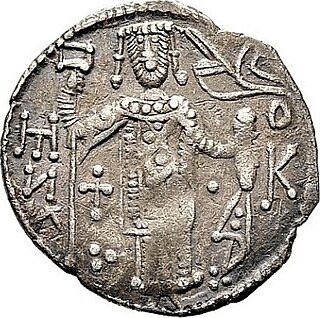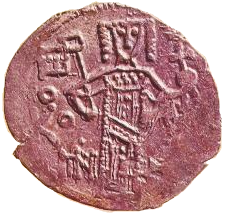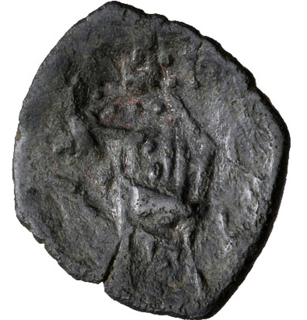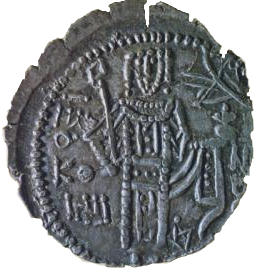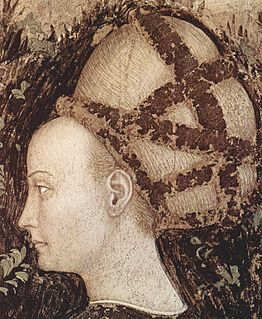Limnia (Greek : τα Λιμνία) was the westernmost subdivision of the medieval Empire of Trebizond, consisting of the southern coastline of the Black Sea around the mouth of the Yeşilırmak River.

Greek is an independent branch of the Indo-European family of languages, native to Greece, Cyprus and other parts of the Eastern Mediterranean and the Black Sea. It has the longest documented history of any living Indo-European language, spanning more than 3000 years of written records. Its writing system has been the Greek alphabet for the major part of its history; other systems, such as Linear B and the Cypriot syllabary, were used previously. The alphabet arose from the Phoenician script and was in turn the basis of the Latin, Cyrillic, Armenian, Coptic, Gothic, and many other writing systems.

The Empire of Trebizond or the Trapezuntine Empire was a monarchy and one of three successor rump states of the Byzantine Empire that flourished during the 13th through 15th centuries, consisting of the far northeastern corner of Anatolia and the southern Crimea. The empire was formed in 1204 after the Georgian expedition in Chaldia, commanded by Alexios Komnenos a few weeks before the sack of Constantinople. Alexios later declared himself Emperor and established himself in Trebizond. Alexios and David Komnenos, grandsons and last male descendants of deposed Emperor Andronikos I Komnenos, pressed their claims as "Roman Emperors" against Byzantine Emperor Alexios V Doukas. The later Byzantine emperors, as well as Byzantine authors, such as George Pachymeres, Nicephorus Gregoras and to some extent Trapezuntines such as John Lazaropoulos and Basilios Bessarion, regarded the emperors of Trebizond as the “princes of the Lazes”, while the possession of these "princes" was also called Lazica, in other words, their state was known as the Principality of the Lazes. Thus from the point of view of the Byzantine writers connected with the Laskaris and later with the Palaiologos dynasties, the rulers of Trebizond were not emperors.
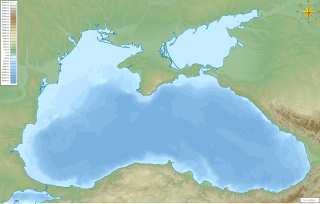
The Black Sea is a body of water and marginal sea of the Atlantic Ocean between the Balkans, Eastern Europe, the Caucasus, and Western Asia. It is supplied by a number of major rivers, such as the Danube, Dnieper, Southern Bug, Dniester, Don, and the Rioni. Many countries drain into the Black Sea, including Austria, Belarus, Bosnia and Herzegovina, Bulgaria, Croatia, Czech Republic, Georgia, Germany, Hungary, Moldova, Poland, Romania, Russia, Serbia, Slovakia, Slovenia, Turkey and Ukraine.
Anthony Bryer traces its origins to a Byzantine supply base named Kinte, used by Emperor John II Komnenos in the winter solstice of 1140. By the next century, it had "finally became the Trapezuntine stronghold of Limnia, with a see and thirteen imperial fortresses; it figures on portolan maps until the sixteenth century." [1] In 1297, the Trapezuntine Emperor John II Grand Komnenos died while in Limnia. [2] In 1317, according to Bryer, although it "was the last and lowliest of the suffragans of Amaseia its bishops assumed the metropolitan rights of the inland city." [3] On the other hand, Spyros Vryonis explains that the metropolitan of Amaseia, one Callistus, who had been appointed to fill a long-standing vacancy in 1315, had been unable to enter his see and in 1317 a synodal decree directed him to reside in Limnia "until conditions improved and the Turks would permit him to enter Amaseia." [4]

Anthony Applemore Mornington Bryer was a British historian of the Byzantine Empire and founder of the Centre for Byzantine, Ottoman and Modern Greek Studies at the University of Birmingham.

The Byzantine Empire, also referred to as the Eastern Roman Empire or Byzantium, was the continuation of the Roman Empire in its eastern provinces during Late Antiquity and the Middle Ages, when its capital city was Constantinople. It survived the fragmentation and fall of the Western Roman Empire in the 5th century AD and continued to exist for an additional thousand years until it fell to the Ottoman Turks in 1453. During most of its existence, the empire was the most powerful economic, cultural, and military force in Europe. Both the terms "Byzantine Empire" and "Eastern Roman Empire" are historiographical terms created after the end of the realm; its citizens continued to refer to their empire simply as the Roman Empire, or Romania (Ῥωμανία), and to themselves as "Romans".

John II Komnenos or Comnenus was Byzantine Emperor from 1118 to 1143. Also known as "John the Beautiful" or "John the Good" (Kaloïōannēs), he was the eldest son of Emperor Alexios I Komnenos and Irene Doukaina and the second emperor to rule during the Komnenian restoration of the Byzantine Empire. John was a pious and dedicated monarch who was determined to undo the damage his empire had suffered following the battle of Manzikert, half a century earlier.
In 1384 is the final reference to a bishop of Limnia: a surviving document records that the bishop was directed to take over the administration of Amaseia because the metropolitan could not enter the territory. [5] In 1386, Tajeddin çelebi , emir of Limnia, was succeeded by his son Altamur. Between the two dates, Limnia irrevocably slipped from Trapezuntine control and became a Turkoman possession. [3] Its latest mention is in 1580, on the map of Ortelius. [6]
Çelebi is a Turkish title meaning "gentleman". Notable people with the surname or title include:

The Oghuz, Oguz or Ghuzz Turks were a western Turkic people who spoke the Oghuz languages from the Common branch of Turkic language family. In the 8th century, they formed a tribal confederation conventionally named the Oghuz Yabgu State in central Asia. The name Oghuz is a Common Turkic word for "tribe". Byzantine sources call the Oghuz the Uzes. By the 10th century, Islamic sources were calling them Muslim Turkmens, as opposed to shamanist or Buddhist. By the 12th century this term had passed into Byzantine usage and the Oghuzes were overwhelmingly Muslim.
